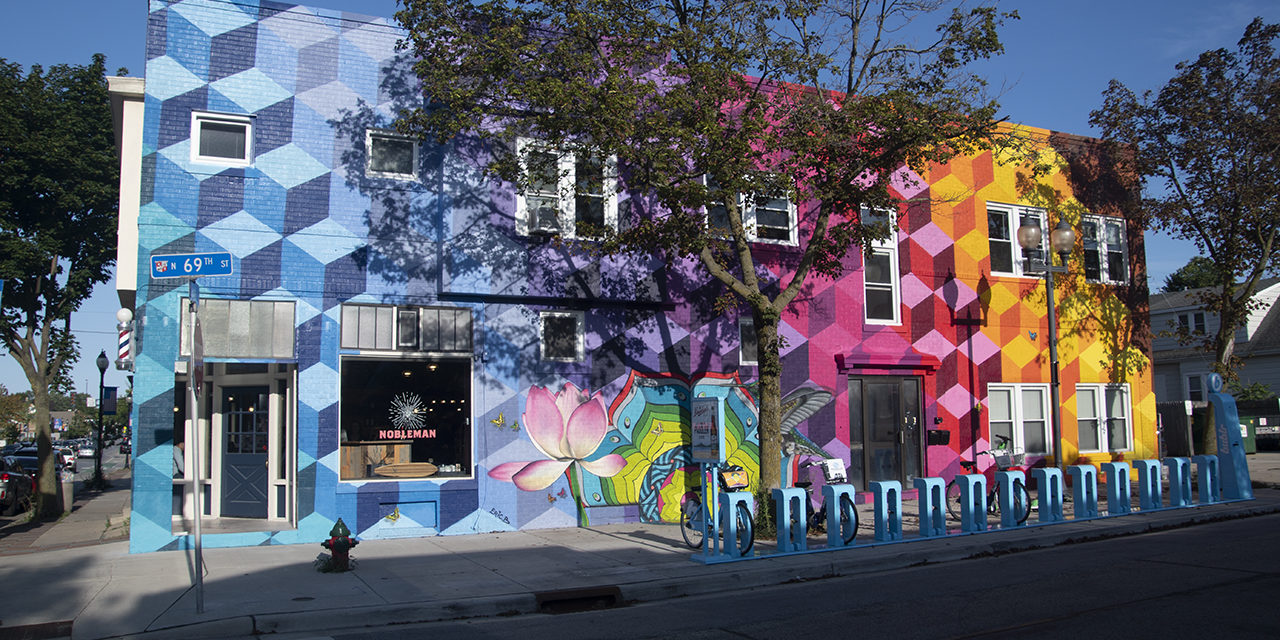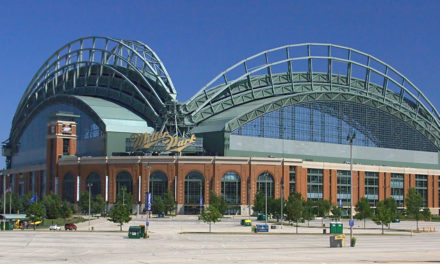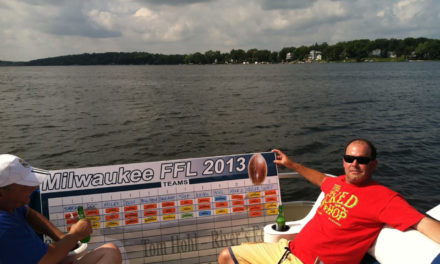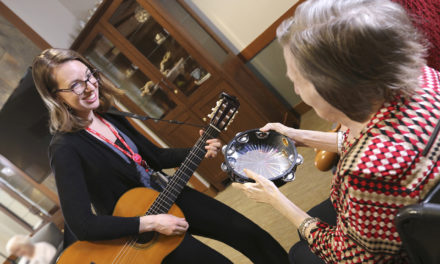By Jenny Wisniewski
In late July, seven artists from near and far gathered to enliven the facades of seven North Avenue businesses. Each was commissioned to paint a mural on one of the selected buildings. How far? Miami, Ireland, even an artist originally from Liberia and now a resident of Maryland. And the near? Five blocks away from the mural she created.
One of these murals, a goldfish in the forefront, interweaving vines and flowers in the background, now graces the west side of Tosa Yoga, 6734 W. North Avenue. The process began on a Friday night when the artist, Ivan Roque, projected the image on the side of the building, tracing the outlines with black spray paint. From this skeleton, he began filling in the background of the mural working his way forward with the details. All of the painting was completed with spray paint.
While passersby stopped to watch the muralist at work on his mechanized lift, Ivan Roque greeted me enthusiastically and took a break from his work, which he would complete in two days, to discuss his life as a muralist.
A son of Cuban immigrants, Roque grew up in a blue-collar neighborhood in Miami, Florida. As he was coming of age, he was inspired by a newly rejuvenated Miami neighborhood, formerly a garment district and enclave for Caribbean immigrants, called Wynwood. Artists filled the empty walls with colorful murals, reinvigorating the area. It is now world-famous for its art.
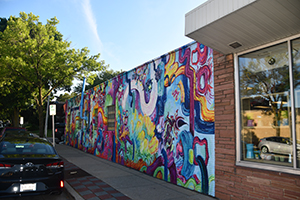 With the inspiration of Wynwood and the encouragement of his Mom, who told him she wanted him “to wake up and be happy with what he was doing each day,” Roque entered art school at Florida International University and began to work as an assistant to another muralist.
With the inspiration of Wynwood and the encouragement of his Mom, who told him she wanted him “to wake up and be happy with what he was doing each day,” Roque entered art school at Florida International University and began to work as an assistant to another muralist.
He knows that just as he was inspired by the Wynwood muralists, children are among the admirers observing his work along North Avenue. “As a first-generation American, if I can do it, anyone can do it,” he said.
While the residents were welcoming of the artists, the weather was not. With temperatures in the 90s and humidity high, it couldn’t have been easy. Then again, Roque is from Miami. The difficult conditions didn’t go unnoticed, however. A local business donated bottled water. Rumor has it that a little girl and her Mom brought popsicles to the artists each day.
Then, on Saturday afternoon, thunderstorms blew through the area. I wondered whether the artists rushed to cover their work. “Battling the elements – that’s one of the fun parts,” Roque laughed when I asked him. “It’s like you versus nature. You hope it doesn’t get messed up, but if it does, you go back and do it again.”
While Roque waited out the storm at BelAir Cantina, local artist Christina Scheppmann Thomas walked five blocks home to get out of the rain. A three-year resident of Wauwatosa, Scheppmann Thomas is a mixed media artist.
Though she has worked with other artists on murals, this was her first solo project. Her technique differed from the others. Using a drafting crayon, she did a rough mark-up. She then did all of her creating with brushes and paint. Her mural of a woman, representative of Mother Earth with an earth and sky motif on her cloak, now colors the eastern wall of Heartland Information Research, 6434 W. North Avenue.
For business owners, donating their walls with no input on the process was a leap of faith. Melanie Landgraf, owner of Tosa Yoga, came to love both the process and the product. She and her customers watched Roque’s goldfish come to life day-by-day on the studio’s facade. Landgraf appreciated the level of thought that Roque put into the design.
Roque chose the goldfish both because the fish is a yoga pose and the goldfish represents wealth and good fortune in Eastern culture. The interweaving vines represent time and energy, something that connects us, Roque said. The warm colors in the background create a soothing vibe.
“It is peaceful and harmonious. It fits so well with a yoga studio,” Landgraf said.
The Tosa mural project is the brainchild of Wauwatosa Alder Joel Tilleson. During a trip to Austin, Texas, Tilleson visited a neighborhood mural project. He became as intrigued with its audience as the mural itself. Visitors queued to take pictures in front of a mural featuring an enlarged moniker of the city. After snapping a picture or two, the visitors would venture across the street to the coffee shop or a taco truck.
Public art creates economic activity, he observed. An idea was born.
In late 2016, Tilleson began talking to North Avenue business owners to gauge interest. Once he had a core group of owners who wanted to participate in the mural project, he moved forward, working with the Wauwatosa Common Council and next, approaching the Wauwatosa Tourism Commission.
It was the Tourism Commission that ultimately sponsored the project, using revenue from a hotel/motel tax, which by state law can only be spent on tourism-related projects. The commission agreed that the mural project fit the bill.
Roque has witnessed the energy that a project of this nature can bring. “It’s like a formula,” he said. “Murals bring tourism which brings an increase in economic activity. And that brings more Mom and Pops.”
 Tilleson also recruited Wallpapered City, a Milwaukee consulting agency specializing in managing large-scale public art projects. In April 2019 the agency put the call out for artist submissions. The response was overwhelming – over 200 submissions, a significant number of which were international. Tilleson and others on the jury wanted the pieces to be compatible with each other and also coexist well with the buildings.
Tilleson also recruited Wallpapered City, a Milwaukee consulting agency specializing in managing large-scale public art projects. In April 2019 the agency put the call out for artist submissions. The response was overwhelming – over 200 submissions, a significant number of which were international. Tilleson and others on the jury wanted the pieces to be compatible with each other and also coexist well with the buildings.
The East Tosa project fit perfectly with a past project completed by Wallpapered City, as well as its future vision. Painter and muralist Stacey Williams-Ng founded Wallpapered City following the creation of her own cluster of murals, known as Black Cat Alley, on the opposite end of North Avenue on Milwaukee’s east side. Her vision is to create an arts corridor between these two anchors, aptly named NoMAD or the North Avenue Mural Arts District.
Milwaukee has the dubious distinction of being a city with high segregation. Many, drive around neighborhoods in the city rather than through them. “Looking at it in terms of connection, art is a unifier,” Willimas-Ng said. “How can we change the way traffic moves (in this corridor) in a positive way?”
Each neighborhood that embarks on a public art project expresses themselves in a unique way, she believes. “What will neighborhoods along North Avenue choose to say about themselves?”
Based on what Tilleson and Williams-Ng have seen in other cities, opportunities exist for walking, bike or bus tours and maps connecting each of the neighborhoods that host a cluster of murals.
Though the popularity of public art has ebbed and flowed, it has enjoyed renewed attention in recent years. In fact, the street art movement is a “renaissance taking place on a global scale,” according to the Wallpapered City website. In addition to Wynwood, Williams-Ng cited the RiNo district in Denver and even earlier the Bronx, where graffiti and hip-hop art emerged at the same time and eventually led to an increase in artistic expression through murals.
Finishing my conversation with Roque, I zigzagged along North Avenue, peeking at the progress each artist was making within this creativity cluster. I bumped into neighborhood resident Pam McCreary who was doing the same with her young grandsons, Ryan and Romeo. “This just feeds my soul,” she told me. “It is so cool to watch it come to fruition.” An artist herself, McCreary was thrilled by the inspiration the murals provide for the next generation.
“I’m stoked. I’m so happy Wauwatosa has allowed this to happen.”
It Takes a Village…
When seeking a cluster of businesses to donate a wall for the mural project, seven owners stepped forward. They include Bel Air Cantina*, Tosa Yoga, the Voline gas station, Heartland Information Research, Cranky Al’s, Nobleman, and Alfa Flowers**.
*When money became tight, Bel Air Cantina took it a step further and sponsored their own wall.
**Alfa Flowers was sponsored separately, by TripSavvy. Its mural was completed concurrently.
In addition, a number of other businesses pitched in. This includes:
● Sherwin-Williams, which donated $3,000 for artist supplies and materials
● Ray’s Wine & Spirits, which donated a large supply of bottled water to help the artists stay hydrated during the heatwave
● The Residence Inn Milwaukee West, the Radisson Hotel Milwaukee West, and the Hyatt Place Milwaukee-West which donated rooms for the artists or provided significantly discounted rooms

